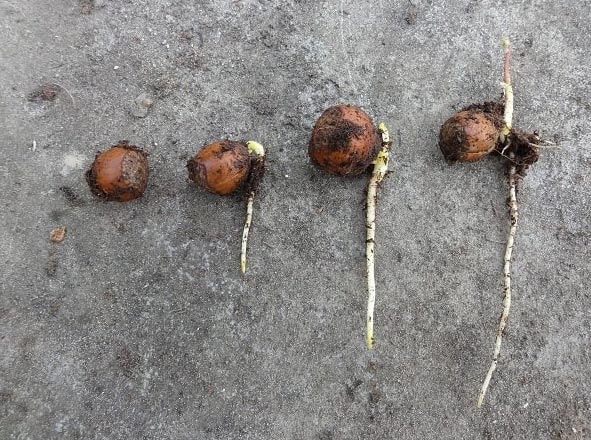Information about saplings and seedlings of trees and shrubs
What are saplings?
Saplings are young trees. They can be produced in various ways:
- Through seed
- Vegetatively through cuttings
Growing saplings by seed
In general, seed produces plants that are variable in genotype and phenotype:
- Genotype is the genetic capacity and characteristics of the plant
- Phenotype is the visible characteristics of the plant
In short, we can say that variable populations of plants differ externally in how they look and differ in their capacities - like growth, resistance, fruit production, etc. Populations grown from seed are far more resistant to diseases for two reasons:
- Through multiplication by seed, the plants are by nature, virus-free
- In a variable population, plants have variable capacities to protect themselves against diseases. If a disease attacks a population originated from seed, one plant may die while another survives as it is less sensitive or not susceptible to that disease
Growing saplings by vegetative multiplication
Multiplication from one plant to a population of many. This can be done through the traditional way of cutting and re-rooting, or through tissue (vitro) culture multiplication. With these methods, all plants have the same genotype and phenotype. Through selection of the mother plant we can choose a plant that has extra capacities like more production, stronger growth, etc. But they are also very vulnerable to diseases to which they have no resistance. Once attacked, the whole population can and often will die.
Vegetative multipliction from a variable population of plants. With this method, the population is more variable than one created by vegetative multiplication from one plant; so it is less sensitive to an attack from disease. The advantage of this method is that we can focus on multiplying mother plants that carry better characteristics than a population that is multiplied through seed. Vegetative multiplication can be done through roots, stems or (small) parts of them.
Root system of plants

An acorn with a single root in the different growth stages
When producing saplings on plugs through seed, a very strong radicle root will be formed. Once growing, this radicle is able to break through even rocks. This is possible because the radicle of a tree is able to develop pressure over 50 bar (=750+ psi)! Look at the image of the seed of the oak (acorn). The second seed on the left is breaking open by the radicle root. At the seed on the right, you see the strong radicle which looks like a nail just a few days old. By putting cuttings on plugs, a radicle is also formed, but it is weaker than a radicle developed from a seed - its growing point is mostly divided between a few weaker roots rather than one strong one. If we multiply saplings using seeds or cuttings in a plug, we prefer a plug to have the following features:
- At least 15 cm (6") deep so that the radicle is able to develop long enough;
- Not rounded - to prevent the root from growing in rounds (horizontal circles) instead of vertically. Once growing in rounds, it will continue so after planting; it will then not be able to penetrate deeply enough to search for capillary water;
- Enough openings so that the roots have sufficient oxygen to grow well;
- Easyily handled once the plant is taken out of them.
Once you take the sapling from the plug, you should see white tips and an undivided radicle root. If the tips of the roots are not white, it means that they are infected with a disease like pythium or other moulds. It is also possible that the peat is too salted and the root tips have burned.
Undivided radicle root
During my investigations of roots, I have found that in more than 95% of the occasions, when people are planting trees or bushes, the roots used for planting are wrong. The reason is that they keep the plants too long in the pot; once the strong radicle root reaches the bottom of the pot, it splits into weaker secondary roots. There are also industries where the bushes are multiplied with the bare root system. In vines, for instance, growers multiply their plants in the full ground; and once they are harvested to be transplanted to their final planting location, the growers clean the roots (thereby destroying all the secondary roots) and cut the radicle roots back to 5-10 cm (2" to 4") - and so, destroy the radicle roots.
The current multiplication methods destroy the radicle roots - the roots that in nature, are able to penetrate deeply into the soil with their force of 50 bar (725 psi), and tap capillary water. These same methods stimulate the development of secondary roots with their weak force of only 1 bar (14.5 psi). This means that the nursery industry is creating trees and bushes that are unable to grow without substantial help in dry areas. As a solution to this mistake, we use irrigation. This irrigation is needed not because plants are unable to grow in dry places, but because the plants have an inadequate root system.
Other multiplication methods
There are a few other methods that until now, have not been much used with trees.
- A multiplication method through somatic embryogenic regeneration. This is a method for regeneration of plants of trees by regenerating explants of immature zygotic embryos on a callus induction medium to grow embryogenic tissue. Culturing of the embryogenic tissue is continued on somatic embryo maturation medium and germination medium. The germinated embryos are further converted to acclimatized plants for field planting. The method is well suited for producing clonal planting stock useful for reforestation. This means that this method results in non-variable populations, making them vulnerable for diseases;
- F1-Hybrids from seed. Through inbreeding, various lines of plants are developed. These plants are weaker than their ancestor plants. By combining two inbreeding lines, a newly created F1-hybrid line is made; its descendants have an equal genotype which results in an equal phenotype. The so called ‘hybrid’ effect results in descendants that can easily be more than 30% bigger than the original plants when starting the inbreeding. This means that these plants produce more food, more biomass or more fruit. In general, they grow stongly; but as a result of their non-variability, they are vulnerable to diseases;
- Natural inbreeding through seed. There are plants who have natural inbreeding - for instance, tomatoes. For this reason, the plants are non-variable and all have an equal phenotype.















